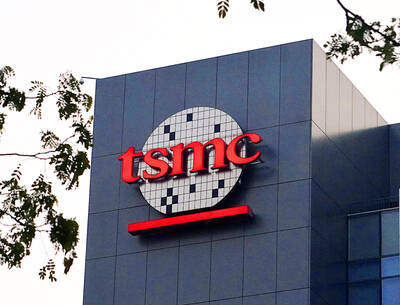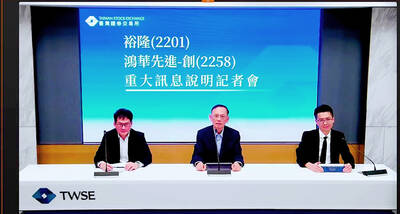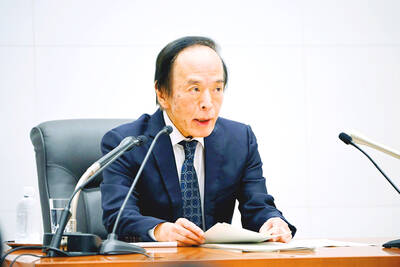Contract chipmaker United Microelectronics Co (UMC, 聯電) yesterday reported its best quarterly profit in one-and-a-half years, thanks to improving demand for computer and communications chips.
Net income last quarter jumped 31 percent to NT$3.84 billion (US$127.36 million), compared with NT$2.93 billion in the third quarter last year and losses of NT$1.71 billion in the fourth quarter of 2018.
Saying its business should benefit from growing demand for 5G-related chips, UMC gave an upbeat outlook for revenue this year.
Chips used in sub-6 gigahertz base stations, radio frequency chips, power management chips and driver ICs for higher-definition OLED panels for smartphones should increase in line with the increasing deployment of 5G networks worldwide, UMC said.
The chipmaker expects its annual revenue to outpace the foundry sector’s forecast growth of a high single-digit percentage, bolstered by contributions from a 12-inch Japanese fab it acquired from Fujitsu Semiconductor Ltd last year, UMC copresident Jason Wang (王石) told investors.
Its revenue last year contracted 2 percent to NT$148.2 billion from NT$151.25 billion in the previous year.
The company expects global semiconductor sales to grow by about 5 percent this year.
“For the first quarter of 2020, based on customer forecasts, the overall business outlook appears to be similar with the previous quarter, primarily due to stable wafer demand from the wireless communications and computer peripheral segments,” Wang said.
The rising demand for 5G and Internet-of-Things applications is expected to generate additional semiconductor demand, specifically in wireless devices, as well as power management, further benefiting UMC, Wang said.
The 2019 novel coronavirus outbreak in China is not expected to affect UMC’s orders this quarter, he said, citing information from customers.
However, should the epidemic worsen, it could imperil the semiconductor supply chain in China, he said.
UMC is closely monitoring its development, he added.
Bigger rival Taiwan Semiconductor Manufacturing Co (TSMC, 台積電) yesterday said it did not expect any impact from the newly imposed transportation restrictions in Nanjing, China, as the virus spread.
TSMC, the world’s largest contract chipmaker, said that its 12-inch fab in the city is operating normally.
UMC said it expects revenue to be little changed in the current quarter from last quarter, given flattish wafer shipments and average selling prices in US dollar terms.
Gross margin is estimated to slide to about 15 percent from 16.7 percent last quarter, it said.
The company plans a capital expenditure of US$1 billion, compared with last year’s US$600 million.
One-third of the capital is to be spent on boosting the capacity of its 28-nanometer fab in Xiamen, China.
Addressing questions about plans to expand capacity in the face of an industrywide oversupply, UMC said that the fab is only 70 percent equipped with machinery and expanding it would boost its profitability.
The company added that it does not expect a quick rebound in utilization as its 28-nanometer technology is still in “recovery mode.”

Taiwan’s long-term economic competitiveness will hinge not only on national champions like Taiwan Semiconductor Manufacturing Co. (TSMC, 台積電) but also on the widespread adoption of artificial intelligence (AI) and other emerging technologies, a US-based scholar has said. At a lecture in Taipei on Tuesday, Jeffrey Ding, assistant professor of political science at the George Washington University and author of "Technology and the Rise of Great Powers," argued that historical experience shows that general-purpose technologies (GPTs) — such as electricity, computers and now AI — shape long-term economic advantages through their diffusion across the broader economy. "What really matters is not who pioneers

In a high-security Shenzhen laboratory, Chinese scientists have built what Washington has spent years trying to prevent: a prototype of a machine capable of producing the cutting-edge semiconductor chips that power artificial intelligence (AI), smartphones and weapons central to Western military dominance, Reuters has learned. Completed early this year and undergoing testing, the prototype fills nearly an entire factory floor. It was built by a team of former engineers from Dutch semiconductor giant ASML who reverse-engineered the company’s extreme ultraviolet lithography (EUV) machines, according to two people with knowledge of the project. EUV machines sit at the heart of a technological Cold

TAIWAN VALUE CHAIN: Foxtron is to fully own Luxgen following the transaction and it plans to launch a new electric model, the Foxtron Bria, in Taiwan next year Yulon Motor Co (裕隆汽車) yesterday said that its board of directors approved the disposal of its electric vehicle (EV) unit, Luxgen Motor Co (納智捷汽車), to Foxtron Vehicle Technologies Co (鴻華先進) for NT$787.6 million (US$24.98 million). Foxtron, a half-half joint venture between Yulon affiliate Hua-Chuang Automobile Information Technical Center Co (華創車電) and Hon Hai Precision Industry Co (鴻海精密), expects to wrap up the deal in the first quarter of next year. Foxtron would fully own Luxgen following the transaction, including five car distributing companies, outlets and all employees. The deal is subject to the approval of the Fair Trade Commission, Foxtron said. “Foxtron will be

INFLATION CONSIDERATION: The BOJ governor said that it would ‘keep making appropriate decisions’ and would adjust depending on the economy and prices The Bank of Japan (BOJ) yesterday raised its benchmark interest rate to the highest in 30 years and said more increases are in the pipeline if conditions allow, in a sign of growing conviction that it can attain the stable inflation target it has pursued for more than a decade. Bank of Japan Governor Kazuo Ueda’s policy board increased the rate by 0.2 percentage points to 0.75 percent, in a unanimous decision, the bank said in a statement. The central bank cited the rising likelihood of its economic outlook being realized. The rate change was expected by all 50 economists surveyed by Bloomberg. The